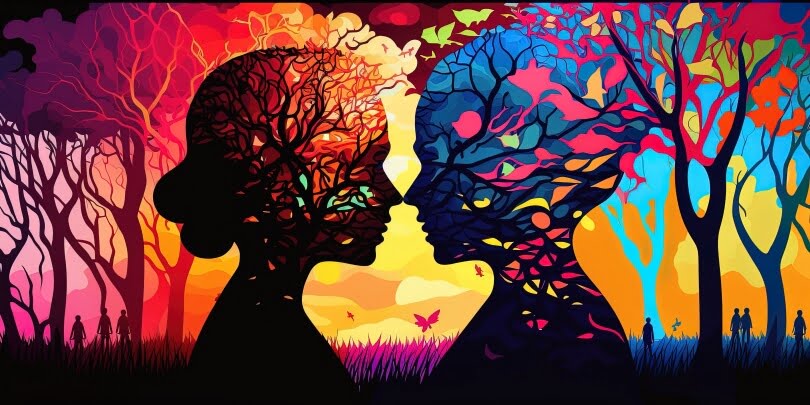Table of Contents
Understanding the Connection Between Dreams and Mental Health

The Science of Dreaming and Its Impact on the Brain
The intricate relationship between dreams and mental health is a fascinating intersection of neurology and psychology. At the heart of this lies the concept of depression management and therapeutic dream analysis. When we talk about depression management, it’s crucial to understand how our brain processes emotions, memories, and experiences, particularly during sleep.
Different stages of sleep play various roles in our mental health, with REM (Rapid Eye Movement) sleep being particularly significant. It is during this stage that our most vivid and emotional dreams occur. Understanding this link can be pivotal in managing depression through dreams.
- Research shows that disrupted REM sleep can exacerbate symptoms of depression. This highlights the need for proper sleep hygiene to mitigate depression.
- Therapeutic dream analysis offers a window into our subconscious, helping to uncover emotional triggers that might be affecting one’s mental health. Such analysis can provide insights for targeted treatments.
- Studies suggest that the content and frequency of nightmares are significantly higher in individuals with depression, indicating a clear connection between dreams and depression.
Practical Implications for Mental Health
For those seeking to improve their mental health, particularly individuals grappling with depression, integrating dream analysis into therapy can be highly beneficial. For example, patients can maintain a dream journal, documenting their dreams to identify recurring themes or anxieties. This can reveal understanding emotional triggers that might otherwise remain hidden in the subconscious.
Moreover, therapeutic interventions can help in interpreting these dreams, thereby assisting in managing depression through dreams. Practical examples include cognitive behavioral therapy (CBT) techniques adapted to address specific dream content or using narrative therapy to rewrite distressing dreams to reduce their emotional impact.
Incorporating these strategies not only deepens our understanding of how dreams can be a reflection of our mental state but also provides tangible methods for improving mental health outcomes. By paying attention to how our brains process emotions during sleep, we can potentially alleviate some of the burdens associated with mental health conditions like depression.
Accumulating evidence underscores the value of continued research in this area, affirming that our nightly journeys through the dream world hold more importance than previously recognized.
Emotional Processing and Dreams
Dreams are often a reflection of our emotional states and can play a significant role in managing depression and understanding emotional triggers. By engaging in therapeutic dream analysis, individuals can gain valuable insights into their subconscious minds, uncovering hidden fears and desires that contribute to their emotional well-being. For instance, a person struggling with dreams and depression might repeatedly dream of falling, which can indicate feelings of loss of control or internal chaos. This dream pattern offers critical insights for depression management.
- Dreams can serve as a window into our subconscious, highlighting hidden anxieties and emotional triggers.
- Therapeutic dream analysis can help individuals process emotions that may not be immediately apparent in their waking lives.
- Many people use dream analysis as a tool for managing depression through dreams, gaining a better understanding of their emotional landscapes.
Real-Life Examples and Practical Applications
In a real-life case, a patient named Sarah found herself suffering from recurring nightmares about drowning. Through therapeutic dream analysis, she discovered that these nightmares were linked to her overwhelming stress at work and feelings of inadequacy. By recognizing this emotional trigger, she could confront these challenges more proactively, thereby improving her mental health.
Another example is of John, who continually dreamt of being lost in a vast, empty space. This dream mirrored his feelings of isolation and emotional detachment following the loss of a loved one. By understanding this, John could begin addressing his grief more effectively, demonstrating how managing depression through dreams can be a powerful tool.
Engaging with dreams and emotional states can offer substantial benefits. By decoding the symbolic language of our subconscious, we become better equipped to address the root causes of our emotional distress. Understanding emotional triggers in dreams offers a unique pathway to mental health improvement, making therapeutic dream analysis an invaluable resource.
In summary, dreams offer a rich tapestry through which we can explore our inner emotional worlds. From depression management to understanding emotional triggers, the practice of therapeutic dream analysis can significantly enhance our mental health. Real-life case studies like those of Sarah and John illustrate the profound impact that understanding our dreams can have on our well-being.
Techniques for Using Dream Analysis to Manage Depression

Managing Depression Through Dream Analysis
Managing depression involves multiple strategies, one of the most intriguing being therapeutic dream analysis. This method leverages our dreams to understand emotional triggers and manage depressive symptoms. Dream analysis can be a valuable tool in depression management when approached systematically.
One effective method in managing depression through dreams is the practice of dream journaling. By keeping a record of dreams, one can begin to see patterns and themes that emerge over time. This technique offers a tangible way to connect subconscious thoughts with conscious emotions, aiding in understanding emotional triggers. For example, a person might notice recurring themes of abandonment, which could correlate with feelings of loneliness in waking life.
- Consistent journaling provides a chronological record that can reveal emotional patterns.
- Reviewing the journal with a therapist can offer insights into subconscious fears or desires.
- Observing changes over time helps in tracking the progress of depressive symptoms.
Thematic Analysis in Dream Interpretation
Thematic analysis dives deeper into the content of dreams by identifying recurring symbols and narratives. This method helps individuals recognize underlying issues contributing to their depression. For example, frequent dreams about failing or being chased might indicate pervasive feelings of inadequacy or anxiety. Understanding these themes can clarify emotional triggers and provide avenues for more targeted intervention.
Another key aspect is the identification of recurrent symbols within dreams. Symbols like water, darkness, or lost objects could hold significant meaning linked to one’s emotional state. By interpreting these symbols, a therapist can guide individuals toward a deeper self-understanding. A person who frequently dreams of water might be dealing with overwhelming emotions, while darkness could symbolize feelings of uncertainty or fear.
- Identifying symbols provides a focus for therapeutic discussions.
- Symbols can serve as metaphors for deeper emotional struggles.
- This technique offers a rich, nuanced approach to therapeutic dream analysis.
Real-life examples illustrate the effectiveness of such methods. Consider Jane, who battled chronic depression. By engaging in dream journaling and thematic analysis, she identified a recurring theme of helplessness linked to her childhood experiences. With her therapist, she explored these dreams, leading to breakthrough moments that significantly alleviated her depressive symptoms.
Therefore, managing depression through dreams involves more than merely recounting them. It requires a methodological approach that includes dream journaling, thematic analysis, and symbol identification. These strategies offer valuable insights into emotional triggers, aiding in more effective therapeutic interventions. By understanding the language of dreams, individuals can better navigate their emotional landscapes, ultimately enhancing mental health.
Practical Applications and Case Studies
Dreams and their relationship with mental health have fascinated both researchers and clinicians for centuries. However, it’s not just an academic curiosity – it holds practical implications for depression management through therapeutic dream analysis. Analyzing dreams can offer profound insights into understanding emotional triggers, making it a valuable tool in managing depression.
To illustrate, let’s consider a case where therapeutic dream analysis played a pivotal role. A patient suffering from severe depression reported recurring dreams of being overwhelmed by dark waves. These dreams were not just figments of their imagination, but rather expressions of deep-seated emotional struggles. By analyzing these dreams in a therapeutic setting, the therapist helped the patient identify the overwhelming waves as a metaphor for their repressed feelings of inadequacy and fear.
- This awareness offered the patient a new understanding of their emotional triggers.
- Through dream analysis, they could get to the root of their depressive symptoms.
- Over time, this understanding led to better depression management techniques.
The Role of Dreams in Depression Management
Therapeutic dream analysis is increasingly recognized as a legitimate tool in managing depression. Consider another example of a patient who had recurrent dreams about being chased. Initially, this seemed like a typical anxiety dream, but deeper analysis revealed it was connected to their ongoing struggle with workplace stress. By exploring this through dream analysis, the therapist and patient worked together to devise strategies for addressing the stress and, consequently, improving their mental health.
By understanding emotional triggers revealed in dreams, therapists can offer more tailored guidance for managing depression. This methodology is supported by numerous studies that highlight the efficacy of integrating dream analysis into broader therapeutic practices.
Integrating Dream Analysis into Therapeutic Practices
Mental health practitioners often share success stories where therapeutic dream analysis provides actionable insights. For instance, a study showed that patients who engaged in dream analysis sessions experienced a faster reduction in depressive symptoms compared to those who didn’t. This underscores its potential as a powerful component in a comprehensive mental health regimen.
- Therapists can guide patients to keep dream journals, noting recurring themes and symbols.
- Regular sessions focused on dream analysis can help uncover hidden emotional triggers.
- Combining dream analysis with conventional therapy often yields more robust outcomes.
In summary, the use of dream analysis can significantly contribute to depression management. By offering a window into the subconscious, dreams provide valuable clues for therapeutic intervention, helping patients understand and manage their emotional triggers more effectively. For anyone grappling with mental health issues, integrating dream analysis into their therapy could be a transformative step towards better emotional health.
Summary
The intricate relationship between dreams and mental health is a fascinating intersection of neurology and psychology. Managing depression through dream analysis can provide valuable insights into one’s emotional state, revealing hidden triggers of depression.
Research has shown that disrupted REM (Rapid Eye Movement) sleep can worsen symptoms, emphasizing the importance of sleep hygiene in managing depression. Therapeutic dream analysis helps uncover subconscious emotional triggers, offering targeted treatment opportunities. People with depression often experience more frequent and intense nightmares, indicating a link between dreams and depression.
- Disrupted REM sleep can exacerbate depression symptoms, highlighting the importance of proper sleep hygiene.
- Therapeutic dream analysis can help uncover emotional triggers affecting mental health.
- Individuals with depression often experience more intense and frequent nightmares.
Practical Implications for Mental Health
Maintaining a dream journal can be a powerful tool for managing depression through dreams, helping identify recurring themes or anxieties. This can offer insights into understanding emotional triggers that might be hidden in the subconscious. Techniques like cognitive behavioral therapy (CBT) can be adapted to address specific dream content, providing actionable pathways for managing depression through dream analysis.
Real-life examples illustrate this well. For instance, Sarah’s recurring nightmares about drowning revealed links to overwhelming stress at work, which helped her confront and manage these challenges. Similarly, John’s dreams of being lost mirrored his feelings of isolation and grief, enabling him to address these emotional states more effectively.
- Maintaining a dream journal can reveal patterns and emotional themes.
- CBT techniques can be adapted to dream content for targeted treatment.
- Real-life cases show the benefits of understanding dreams for emotional well-being.
Incorporating dream analysis into therapeutic practices can significantly enhance mental health outcomes by offering a deeper understanding of one’s emotional landscape. By decoding the symbolic language of dreams, individuals can alleviate the burdens associated with depression, paving the way for better emotional health.
FAQ – Managing Depression Through Dream Analysis
How can recurring symbols or themes in dreams be utilized in therapy to uncover underlying emotional triggers and aid in managing depression?
Recurring symbols or themes in dreams can serve as windows into the subconscious mind, helping therapists identify unresolved emotional conflicts that contribute to depression. By analyzing these patterns, therapists can gain insights into the root causes of distress, facilitating targeted interventions and self-awareness. For instance, a recurring dream of being trapped might reflect feelings of entrapment in waking life, guiding therapeutic strategies to address such emotions and improve mental health.
How can recurring dream themes be used to identify and address underlying emotional triggers in therapy for depression?
Recurring dream themes offer valuable insights into a person’s subconscious mind, often highlighting unresolved emotional conflicts or stressors. By exploring these themes in therapy, individuals can uncover hidden emotions or trauma, which can then be addressed to alleviate depressive symptoms. For instance, frequent dreams of falling might reveal feelings of insecurity or loss of control, guiding therapeutic interventions to build self-esteem and coping mechanisms.
How can reoccurring themes in dreams help identify underlying emotional triggers contributing to depression?
Reoccurring themes in dreams can serve as a window into the subconscious mind, often revealing deeply rooted emotional conflicts or unresolved traumas that contribute to depression. By examining these patterns, individuals, alongside mental health professionals, can identify and address hidden stressors or fears that may be difficult to articulate or recognize in waking life. This process can facilitate emotional healing and provide actionable insights for therapeutic intervention, ultimately supporting better mental health and well-being.




